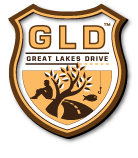Fishing The Bois Brule
Fishing The Bois Brule
Bois Brule River, Wisconsin
Bois Brule Fishing
The spring steelhead run usually begins in late March and extends through May. During the first several weeks of the early season, the vast majority of steelhead caught are fish that remained in the river from the previous fall run. Bright, spring-run fish start appearing in April and continue through early May. Water temperatures dictate peak movement. Most fish are taken on yarnflies, spawn, large caddis fly imitations, and various types of hardware (i.e., spoons and spinners). The deep runs and pools are favorite holding areas for the fish.
A small run of chinook salmon ascend the river from early July through mid-October with a peak somewhere during mid-August to late September. Most chinook are taken soon after they enter the stream. At this time they are still silver and are quite a battle for even the most experienced fisherman. They seem to prefer flashing lures like spinners or spoons and tend to hold in the slower, deep water.
The lake run of brown trout begins in early July and extends through late October. The peak is from mid-July to mid-September. Favorite baits include spoons, spinners, flatfish, and live bait such as night crawlers. The brown is not an easy fish to catch, but with persistence and by fishing the slower, deep holes during low-light periods, the odds of landing one should be in your favor.
Coho salmon are found moving up the Brule from late August to late November. Depending on water conditions, the peak is usually sometime in September. Coho can be caught on a variety of bait selections. They seem to prefer the slower water areas.
The fall run of steelhead begins moving up the Brule in mid-August and continues through late November. The largest runs usually occur sometime between mid-September and late October. Water conditions (i.e., temperature, water level, clarity) will affect the exact timing of the run, so the peak will vary from year-to-year. One can expect to find the fish associated with the moderate velocity areas but usually behind or near some type of current break (i.e., rocks, logs, stream bank). They will tend to hold in the deeper holes as the water temperature drops later in the season. A wide variety of baits which includes yarnflies, spawn, flatfish, and all types of spoons and spinners are appealing to fall-run steelhead.
The river north of U.S. Hwy. 2 has many well-marked day-use access points all the way to Lake Superior. They are located throughout the lower river and provide an excellent opportunity to fish different sections of the river as it changes character. Overnight camping is limited to designated campgrounds.
The section of river south of Co. Hwy. B is noted for its resident brown and brook trout fishery. Some of the best fishing occurs in the stretch between Co. Hwy. B and Co. Hwy. S. (special regulations stretch). This part of the river is slow and wide and is excellent for fly fishing. The larger insect hatches occur in this area from May to the end of June. This area gets a heavy amount of canoe traffic during the summer months, especially during weekends.
The land adjacent to the river between Stones Bridge on Co. Hwy. S to just below Co. Hwy. B is mostly privately owned, so access is limited.
There are two state forest campgrounds located on the Brule River. Copper Range is located approximately four miles north of the town of Brule. The other (Bois Brule) is located near the Ranger Station, about one mile southwest of Brule. There is no electricity provided at either of these sites. If it is desired, a private campground (Brule River Campground) is located in Brule on U.S. Hwy. 2.
Great Trout Fishing Link
Stephen Rose and I had just come back to the river after lunch on our second day of Steelhead fishing. The first day yielded a couple of nice fish and a couple of smaller jacks. We had help from Steelhead ninja Tim, of Fly By Night Outfitters that first day out, and we were hoping to capitalize on what we’d learned. We spent the morning of the second day fishing a section of river we weren’t familiar with, scared away from known sections of the river by cars. Bad choice. We were too far downstream, there weren’t any holes, and there weren’t any fish. So, back to after lunch. We parked in a familiar place and hit all the spots Tim had shown us the first day. As the afternoon passed, and our casting arms tired, it was looking like a bust. But then, on a long downstream drift, the indicator popped. It didn’t look like a snag, and indeed it was not. I raised my rod tip and pulled on the line with my stripping hand, and I had a fish on! The fish only stayed under for a second, then made a big, broad-sided leap fully out of the water. I got a look at it and it seemed to be a hand over two feet long. Nice! Back into the water splashed the fish, and that’s when Stephen looked upstream and saw the aftermath of the acrobatics. And then, it was gone. Snapped off in a flash. My exhilirating connection with that beautiful creature was severed….
..Read The Entire Article at the link below.
Trout Seekers WebsiteBois Brule Fishing WDNR
Wisconsin Trout Fishing Regulations
All content the property of Wisconsin Forestry. Photography the property of Tom Anderson and seekingtrout.com


